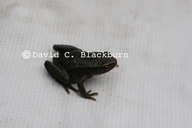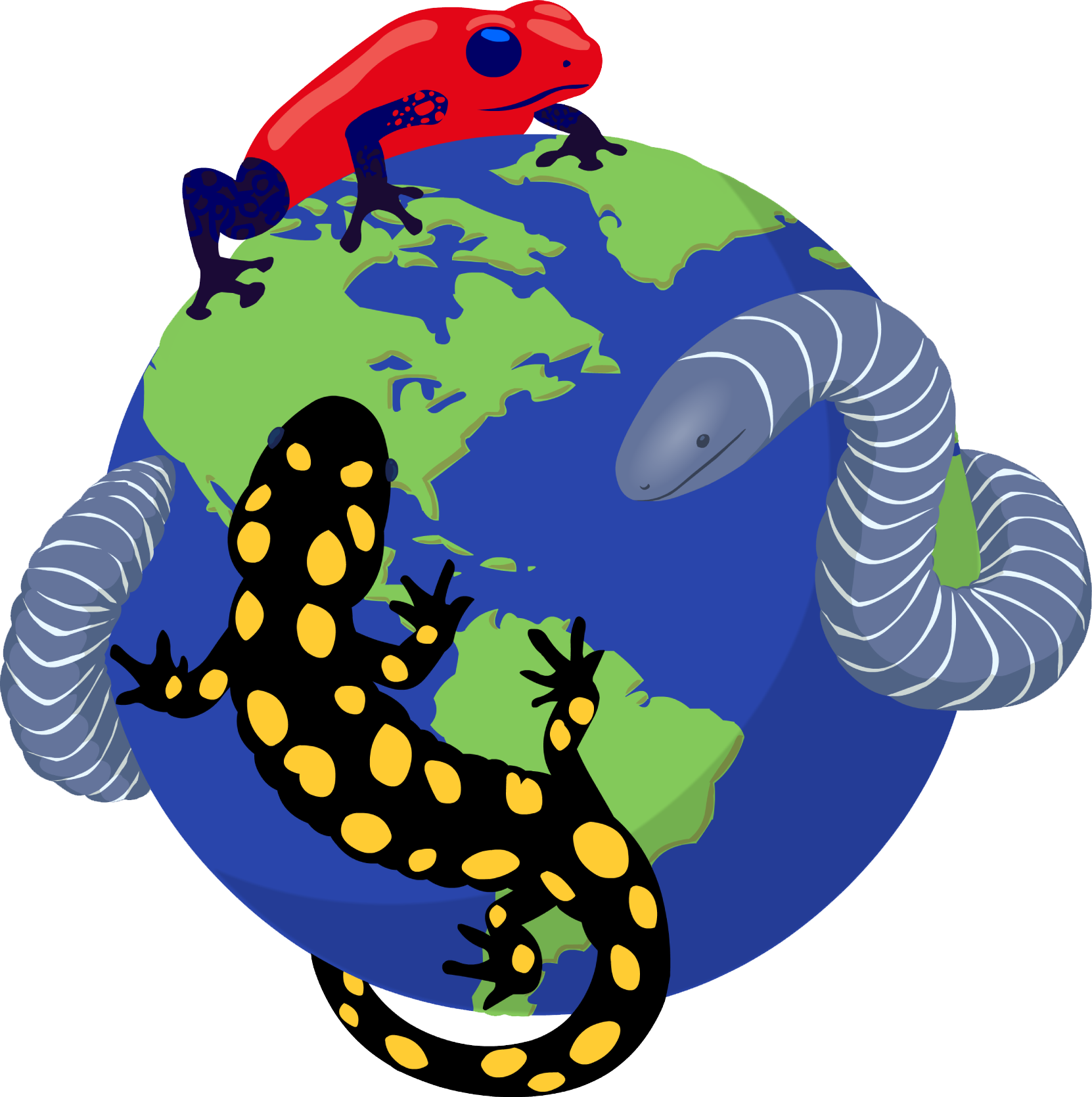|
Werneria bambutensis (Amiet, 1972)
Bamboutos Smalltongue Toad | family: Bufonidae genus: Werneria |
 © 2007 Dave Blackburn (1 of 5) |
|
|
|
Description Tadpoles typically range from 13.2 – 18.5 mm in total length at Gosner stage 25. Their body plan is generally characterized by Orton tadpole type IV, much like other bufonid species. Their bodies are robust, wide, and have relatively short tails with a narrow fin. A dorsal fin protrudes from the base of the tail, and a ventral fin protrudes adjacent the vent opening. The fin tip is rounded, and the nostrils, which are small and slightly curved, are positioned on the dorsal side of the tadpole. The eyes are typically positioned dorsolaterally and in close proximity to the snout. A short and narrow sinistral spiracle begins near the end of the body and is rarely visible from a dorsal view. Their mouth is keratinous and contains a labial tooth row, narrow upper jaws, flat and narrow lower jaws, and an oral disc with a width equivalent to the width of the body. The anterior lip has no papillae but has supra-angular teeth rows and is rounded with a median gap, while the posterior lip is covered in papillae and comprises two circular and broad dermal lobes (Hirschfeld 2012). Werneria bambutensis is the smallest of the Werneria species and may be diagnosed from its congeners in a number of ways. They typically have a rounded snout, fully webbed toes, short and thick posterior legs, and an enlarged terminal phalanx. They lack well-defined dorsolateral bands, but males have more developed spinosities compared to other species (Rödel et al. 2004). And a stream-dwelling lifestyle and an expanded oral disc in the larval form are characteristics of W. bambutensis and W. preussi to the exclusion of their congeners (Amiet 1976, Rödel et al. 2004). Colors in this species vary. In life, their dorsal colors are dark green. In alcohol, their dorsal colors typically range from bronze with a slight touch of gold or black spots to a dark green, brown or black. Their ventral side typically ranges from white to grey and may have grey spots. Lateral coloration is darker than dorsal coloration, and faint dorsolateral lines may be seen on the sides of their head (Rödel et al. 2004). In tadpoles, the dorsal side is brown while the ventral side is typically spotted with brown dots. A transparent horizontal band behind its eye is also seen, however, it is much less prominent than in other Werneria species. The fin does not have a pattern but is grey in color and the tail is a light brown color and is typically clearer than the body (Hirschfeld 2012). Aside from the aforementioned color differences, there is no significant variation within the species. Distribution and Habitat Country distribution from AmphibiaWeb's database: Cameroon
Life History, Abundance, Activity, and Special Behaviors The lack of tympanum, columella, and vocal sacs suggests that these frogs do not vocalize to one another. In fact, this species may be mute (Amiet 1972). Researchers dissected two gravid females from a museum collection and counted 380 and 483 unpigmented eggs, respectively. The eggs were 2 millimeters in diameter. Not enough is known about the reproduction of this endangered species to yet ascertain a typical clutch size, but it is likely inherent within a range of the aforementioned values. Werneria bambutensis larvae develop as free-swimming tadpoles (Amiet 1972). Trends and Threats Although the species is highly reliant on a few select mountainous streams in Cameroon, they are relatively resilient. They can tolerate long dry seasons (two or more months) and have a greater thermal and altitudinal tolerance than any of its congeners (Rödel et al. 2004). Individuals that may occur in the Bafut-Ngemba Forest Reserve are protected, but the species remains unprotected where it occurs elsewhere. The remaining highland forests in Cameroon, in particular Mt. Manengouba, require protection for the continued existence of the species. As of 1985, the species has been considered to be nearing extinction in the Bamboutos Mountains (Stuart et al. 2008). Relation to Humans Possible reasons for amphibian decline General habitat alteration and loss Comments Werneria bambutensis belongs to the family Bufonidae. Frank and Ramus (1995) report four known species of the genus Werneria (W. bambutensis, W. martensiana, W. preussi, and W. tandyi), although two more species have since been described by Rödel et al. (2004; W. iboundji and W. submontana). The species name bambutensis derives from the Bamboutos Mountains, which is part of the range in which it occurs (Stuart et al. 2008).
References
Amiet, J. L. (1976). ''Observations anatomique et biologique sur le genre Werneria Poche, 1903.'' Revue de Zoologie Africaine, 90, 33-45. Amiet, J.-L. (1972). ''Description de trois Bufonidés orophiles du Cameroun appartenant au groupe de Bufo preussi Matschie (Amphibiens Anoures).'' Annales de la Faculté des Sciences du Cameroun, 11, 121-140. Cronin, D. T., Libalah, M. B., Bergl, R. A., Hearn, G. W. (2014). ''Biodiversity and conservation of tropical montane ecosystems in the Gulf of Guinea, West Africa.'' Arctic, Antarctic, and Alpine Research, 46(4), 891-904. Frank, N. and Ramus, E. (1995). A Complete Guide to Scientific and Common Names of Reptiles and Amphibians of the World. NG Publishing Inc., Pottsville, Pennsylvania. Hirschfeld, M., Barej, M. F., Loader, S. P., Roedel, M.O. (2012). ''Description of two Werneria tadpoles from Cameroon.'' Zootaxa, 3172, 65-68. Rödel, M.-O., Schmitz, A., Pauwels, O.S.G. Böhme (2004). ''Revision of the genus Werneria Poche, 1903, including the descriptions of two new species from Cameroon and Gabon (Amphibia: Anura: Bufonidae).'' Zootaxa, 720, 1-28. Stuart, S., Hoffmann, M., Chanson, J., Cox, N., Berridge, R., Ramani, P., Young, B. (eds) (2008). Threatened Amphibians of the World. Lynx Edicions, IUCN, and Conservation International, Barcelona, Spain; Gland, Switzerland; and Arlington, Virginia, USA. Originally submitted by: Nicolas Berry, Jessica Lopez, Rosalynn Sarvi (first posted 2015-06-09) Edited by: Gordon Lau (2018-12-07) Species Account Citation: AmphibiaWeb 2018 Werneria bambutensis: Bamboutos Smalltongue Toad <https://amphibiaweb.org/species/431> University of California, Berkeley, CA, USA. Accessed May 30, 2025.
Feedback or comments about this page.
Citation: AmphibiaWeb. 2025. <https://amphibiaweb.org> University of California, Berkeley, CA, USA. Accessed 30 May 2025. AmphibiaWeb's policy on data use. |



 Map of Life
Map of Life